Epidemiological Profile of Tuberculosis
VerifiedAdded on 2019/12/03
|11
|4326
|295
Report
AI Summary
The provided assignment content focuses on Tuberculosis (TB) and related issues. The articles, journals, and online references discuss various aspects of TB, including co-infection with AIDS, prevention strategies, and the global burden of the disease. Topics covered include epidemiological profiles of urban immigrant populations, infection control measures in hospitals, and adherence to treatment for latent TB infection. Additionally, the content touches on historical perspectives on tuberculosis and the need for sustainable solutions to address access to medicines.
Contribute Materials
Your contribution can guide someone’s learning journey. Share your
documents today.
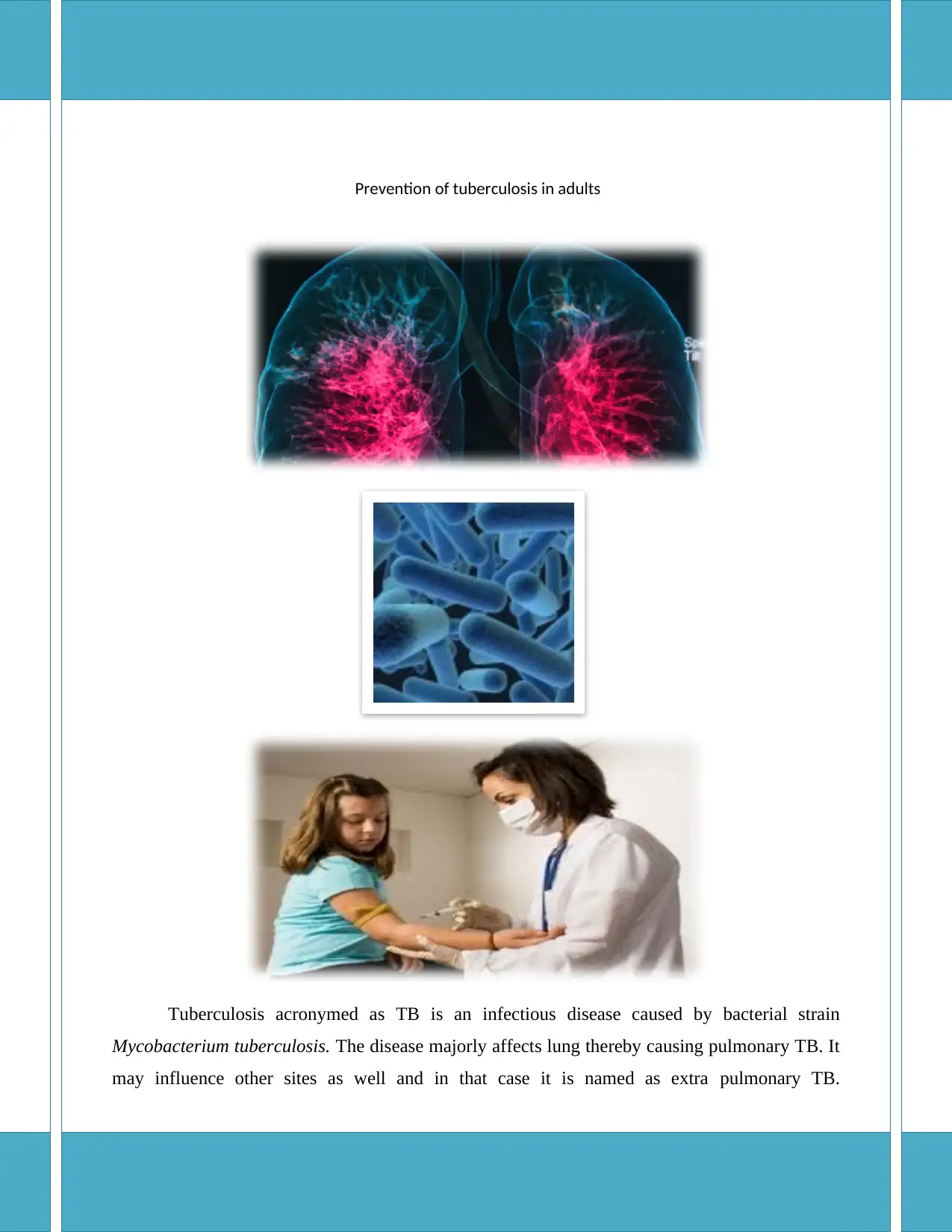
Prevention of tuberculosis in adults
Tuberculosis acronymed as TB is an infectious disease caused by bacterial strain
Mycobacterium tuberculosis. The disease majorly affects lung thereby causing pulmonary TB. It
may influence other sites as well and in that case it is named as extra pulmonary TB.
Tuberculosis acronymed as TB is an infectious disease caused by bacterial strain
Mycobacterium tuberculosis. The disease majorly affects lung thereby causing pulmonary TB. It
may influence other sites as well and in that case it is named as extra pulmonary TB.
Secure Best Marks with AI Grader
Need help grading? Try our AI Grader for instant feedback on your assignments.
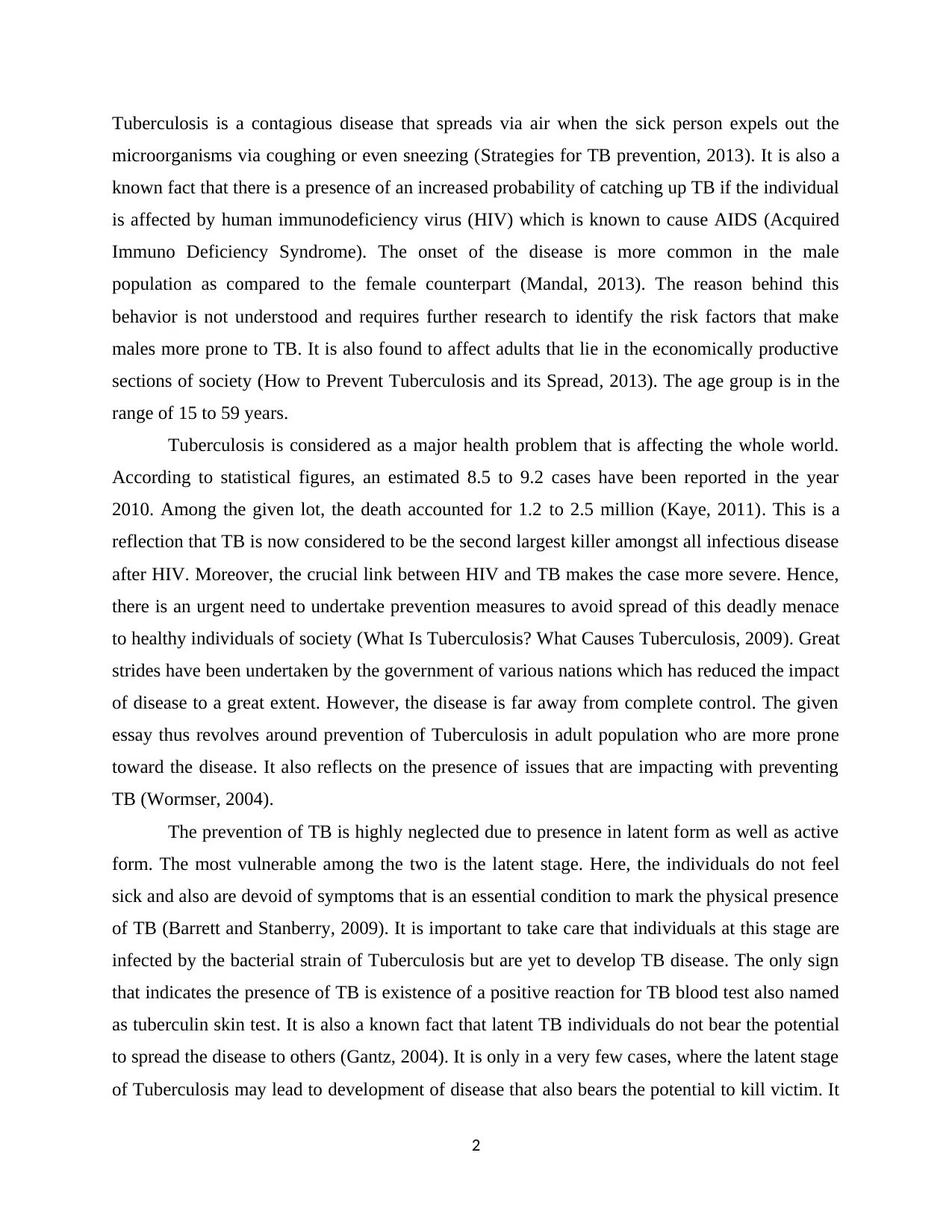
Tuberculosis is a contagious disease that spreads via air when the sick person expels out the
microorganisms via coughing or even sneezing (Strategies for TB prevention, 2013). It is also a
known fact that there is a presence of an increased probability of catching up TB if the individual
is affected by human immunodeficiency virus (HIV) which is known to cause AIDS (Acquired
Immuno Deficiency Syndrome). The onset of the disease is more common in the male
population as compared to the female counterpart (Mandal, 2013). The reason behind this
behavior is not understood and requires further research to identify the risk factors that make
males more prone to TB. It is also found to affect adults that lie in the economically productive
sections of society (How to Prevent Tuberculosis and its Spread, 2013). The age group is in the
range of 15 to 59 years.
Tuberculosis is considered as a major health problem that is affecting the whole world.
According to statistical figures, an estimated 8.5 to 9.2 cases have been reported in the year
2010. Among the given lot, the death accounted for 1.2 to 2.5 million (Kaye, 2011). This is a
reflection that TB is now considered to be the second largest killer amongst all infectious disease
after HIV. Moreover, the crucial link between HIV and TB makes the case more severe. Hence,
there is an urgent need to undertake prevention measures to avoid spread of this deadly menace
to healthy individuals of society (What Is Tuberculosis? What Causes Tuberculosis, 2009). Great
strides have been undertaken by the government of various nations which has reduced the impact
of disease to a great extent. However, the disease is far away from complete control. The given
essay thus revolves around prevention of Tuberculosis in adult population who are more prone
toward the disease. It also reflects on the presence of issues that are impacting with preventing
TB (Wormser, 2004).
The prevention of TB is highly neglected due to presence in latent form as well as active
form. The most vulnerable among the two is the latent stage. Here, the individuals do not feel
sick and also are devoid of symptoms that is an essential condition to mark the physical presence
of TB (Barrett and Stanberry, 2009). It is important to take care that individuals at this stage are
infected by the bacterial strain of Tuberculosis but are yet to develop TB disease. The only sign
that indicates the presence of TB is existence of a positive reaction for TB blood test also named
as tuberculin skin test. It is also a known fact that latent TB individuals do not bear the potential
to spread the disease to others (Gantz, 2004). It is only in a very few cases, where the latent stage
of Tuberculosis may lead to development of disease that also bears the potential to kill victim. It
2
microorganisms via coughing or even sneezing (Strategies for TB prevention, 2013). It is also a
known fact that there is a presence of an increased probability of catching up TB if the individual
is affected by human immunodeficiency virus (HIV) which is known to cause AIDS (Acquired
Immuno Deficiency Syndrome). The onset of the disease is more common in the male
population as compared to the female counterpart (Mandal, 2013). The reason behind this
behavior is not understood and requires further research to identify the risk factors that make
males more prone to TB. It is also found to affect adults that lie in the economically productive
sections of society (How to Prevent Tuberculosis and its Spread, 2013). The age group is in the
range of 15 to 59 years.
Tuberculosis is considered as a major health problem that is affecting the whole world.
According to statistical figures, an estimated 8.5 to 9.2 cases have been reported in the year
2010. Among the given lot, the death accounted for 1.2 to 2.5 million (Kaye, 2011). This is a
reflection that TB is now considered to be the second largest killer amongst all infectious disease
after HIV. Moreover, the crucial link between HIV and TB makes the case more severe. Hence,
there is an urgent need to undertake prevention measures to avoid spread of this deadly menace
to healthy individuals of society (What Is Tuberculosis? What Causes Tuberculosis, 2009). Great
strides have been undertaken by the government of various nations which has reduced the impact
of disease to a great extent. However, the disease is far away from complete control. The given
essay thus revolves around prevention of Tuberculosis in adult population who are more prone
toward the disease. It also reflects on the presence of issues that are impacting with preventing
TB (Wormser, 2004).
The prevention of TB is highly neglected due to presence in latent form as well as active
form. The most vulnerable among the two is the latent stage. Here, the individuals do not feel
sick and also are devoid of symptoms that is an essential condition to mark the physical presence
of TB (Barrett and Stanberry, 2009). It is important to take care that individuals at this stage are
infected by the bacterial strain of Tuberculosis but are yet to develop TB disease. The only sign
that indicates the presence of TB is existence of a positive reaction for TB blood test also named
as tuberculin skin test. It is also a known fact that latent TB individuals do not bear the potential
to spread the disease to others (Gantz, 2004). It is only in a very few cases, where the latent stage
of Tuberculosis may lead to development of disease that also bears the potential to kill victim. It
2
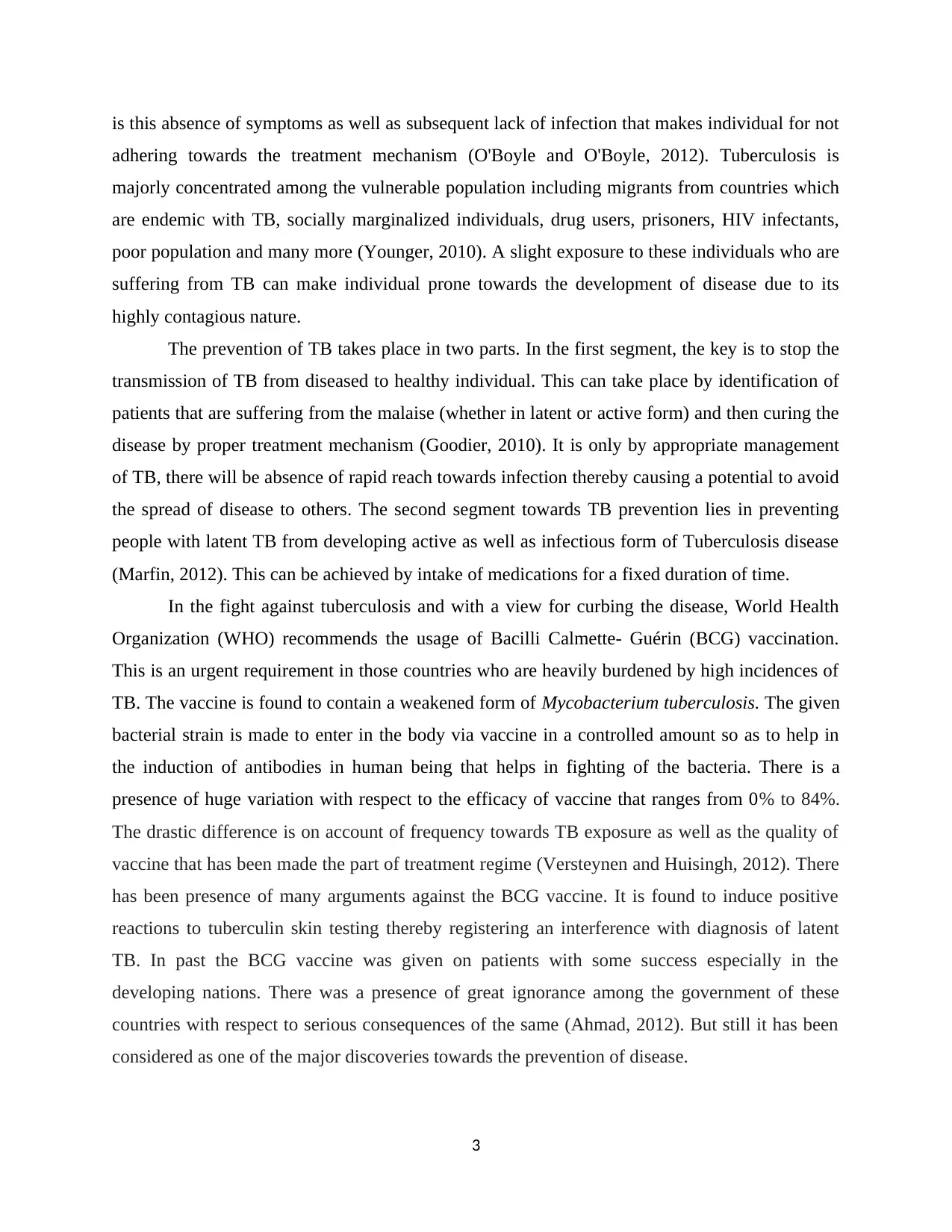
is this absence of symptoms as well as subsequent lack of infection that makes individual for not
adhering towards the treatment mechanism (O'Boyle and O'Boyle, 2012). Tuberculosis is
majorly concentrated among the vulnerable population including migrants from countries which
are endemic with TB, socially marginalized individuals, drug users, prisoners, HIV infectants,
poor population and many more (Younger, 2010). A slight exposure to these individuals who are
suffering from TB can make individual prone towards the development of disease due to its
highly contagious nature.
The prevention of TB takes place in two parts. In the first segment, the key is to stop the
transmission of TB from diseased to healthy individual. This can take place by identification of
patients that are suffering from the malaise (whether in latent or active form) and then curing the
disease by proper treatment mechanism (Goodier, 2010). It is only by appropriate management
of TB, there will be absence of rapid reach towards infection thereby causing a potential to avoid
the spread of disease to others. The second segment towards TB prevention lies in preventing
people with latent TB from developing active as well as infectious form of Tuberculosis disease
(Marfin, 2012). This can be achieved by intake of medications for a fixed duration of time.
In the fight against tuberculosis and with a view for curbing the disease, World Health
Organization (WHO) recommends the usage of Bacilli Calmette- Guérin (BCG) vaccination.
This is an urgent requirement in those countries who are heavily burdened by high incidences of
TB. The vaccine is found to contain a weakened form of Mycobacterium tuberculosis. The given
bacterial strain is made to enter in the body via vaccine in a controlled amount so as to help in
the induction of antibodies in human being that helps in fighting of the bacteria. There is a
presence of huge variation with respect to the efficacy of vaccine that ranges from 0% to 84%.
The drastic difference is on account of frequency towards TB exposure as well as the quality of
vaccine that has been made the part of treatment regime (Versteynen and Huisingh, 2012). There
has been presence of many arguments against the BCG vaccine. It is found to induce positive
reactions to tuberculin skin testing thereby registering an interference with diagnosis of latent
TB. In past the BCG vaccine was given on patients with some success especially in the
developing nations. There was a presence of great ignorance among the government of these
countries with respect to serious consequences of the same (Ahmad, 2012). But still it has been
considered as one of the major discoveries towards the prevention of disease.
3
adhering towards the treatment mechanism (O'Boyle and O'Boyle, 2012). Tuberculosis is
majorly concentrated among the vulnerable population including migrants from countries which
are endemic with TB, socially marginalized individuals, drug users, prisoners, HIV infectants,
poor population and many more (Younger, 2010). A slight exposure to these individuals who are
suffering from TB can make individual prone towards the development of disease due to its
highly contagious nature.
The prevention of TB takes place in two parts. In the first segment, the key is to stop the
transmission of TB from diseased to healthy individual. This can take place by identification of
patients that are suffering from the malaise (whether in latent or active form) and then curing the
disease by proper treatment mechanism (Goodier, 2010). It is only by appropriate management
of TB, there will be absence of rapid reach towards infection thereby causing a potential to avoid
the spread of disease to others. The second segment towards TB prevention lies in preventing
people with latent TB from developing active as well as infectious form of Tuberculosis disease
(Marfin, 2012). This can be achieved by intake of medications for a fixed duration of time.
In the fight against tuberculosis and with a view for curbing the disease, World Health
Organization (WHO) recommends the usage of Bacilli Calmette- Guérin (BCG) vaccination.
This is an urgent requirement in those countries who are heavily burdened by high incidences of
TB. The vaccine is found to contain a weakened form of Mycobacterium tuberculosis. The given
bacterial strain is made to enter in the body via vaccine in a controlled amount so as to help in
the induction of antibodies in human being that helps in fighting of the bacteria. There is a
presence of huge variation with respect to the efficacy of vaccine that ranges from 0% to 84%.
The drastic difference is on account of frequency towards TB exposure as well as the quality of
vaccine that has been made the part of treatment regime (Versteynen and Huisingh, 2012). There
has been presence of many arguments against the BCG vaccine. It is found to induce positive
reactions to tuberculin skin testing thereby registering an interference with diagnosis of latent
TB. In past the BCG vaccine was given on patients with some success especially in the
developing nations. There was a presence of great ignorance among the government of these
countries with respect to serious consequences of the same (Ahmad, 2012). But still it has been
considered as one of the major discoveries towards the prevention of disease.
3
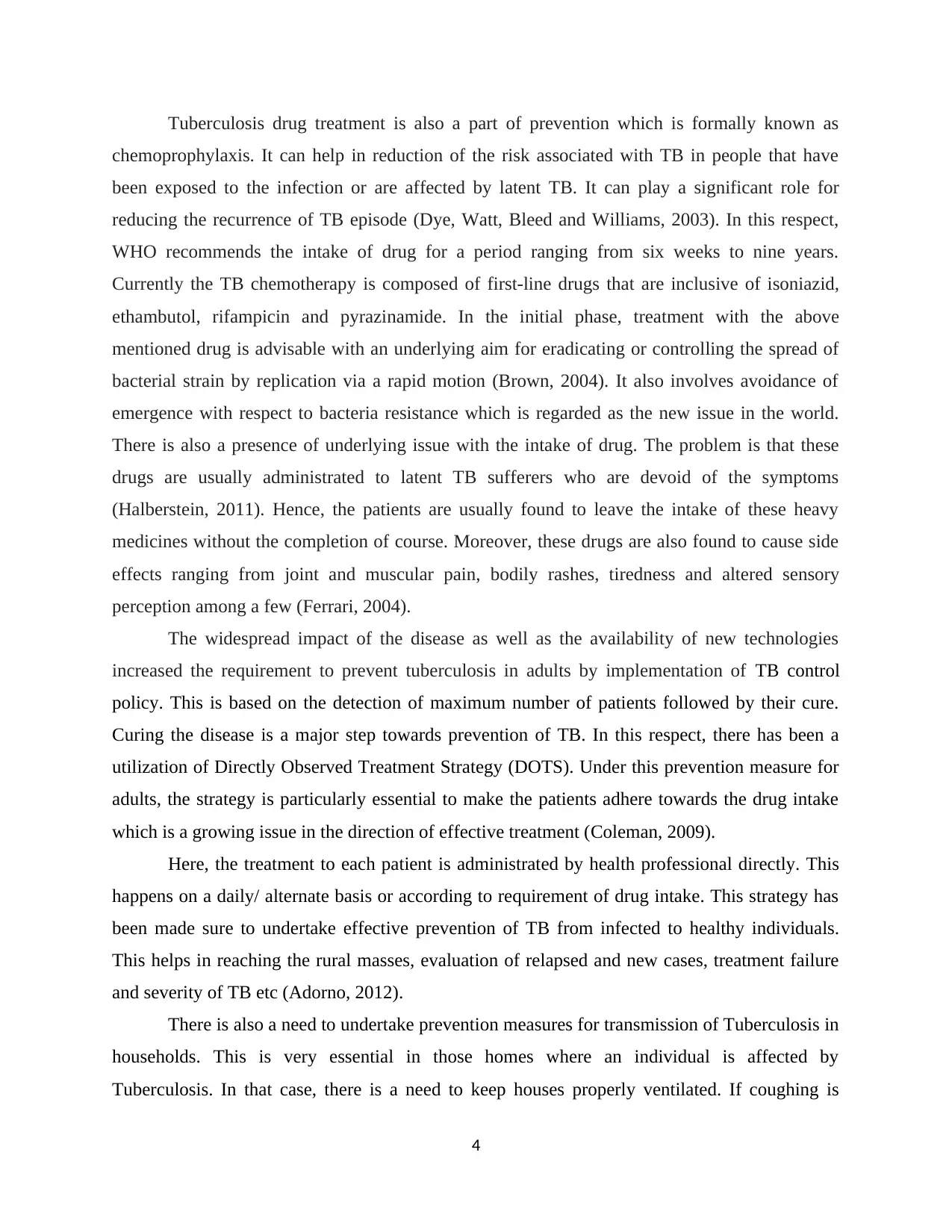
Tuberculosis drug treatment is also a part of prevention which is formally known as
chemoprophylaxis. It can help in reduction of the risk associated with TB in people that have
been exposed to the infection or are affected by latent TB. It can play a significant role for
reducing the recurrence of TB episode (Dye, Watt, Bleed and Williams, 2003). In this respect,
WHO recommends the intake of drug for a period ranging from six weeks to nine years.
Currently the TB chemotherapy is composed of first-line drugs that are inclusive of isoniazid,
ethambutol, rifampicin and pyrazinamide. In the initial phase, treatment with the above
mentioned drug is advisable with an underlying aim for eradicating or controlling the spread of
bacterial strain by replication via a rapid motion (Brown, 2004). It also involves avoidance of
emergence with respect to bacteria resistance which is regarded as the new issue in the world.
There is also a presence of underlying issue with the intake of drug. The problem is that these
drugs are usually administrated to latent TB sufferers who are devoid of the symptoms
(Halberstein, 2011). Hence, the patients are usually found to leave the intake of these heavy
medicines without the completion of course. Moreover, these drugs are also found to cause side
effects ranging from joint and muscular pain, bodily rashes, tiredness and altered sensory
perception among a few (Ferrari, 2004).
The widespread impact of the disease as well as the availability of new technologies
increased the requirement to prevent tuberculosis in adults by implementation of TB control
policy. This is based on the detection of maximum number of patients followed by their cure.
Curing the disease is a major step towards prevention of TB. In this respect, there has been a
utilization of Directly Observed Treatment Strategy (DOTS). Under this prevention measure for
adults, the strategy is particularly essential to make the patients adhere towards the drug intake
which is a growing issue in the direction of effective treatment (Coleman, 2009).
Here, the treatment to each patient is administrated by health professional directly. This
happens on a daily/ alternate basis or according to requirement of drug intake. This strategy has
been made sure to undertake effective prevention of TB from infected to healthy individuals.
This helps in reaching the rural masses, evaluation of relapsed and new cases, treatment failure
and severity of TB etc (Adorno, 2012).
There is also a need to undertake prevention measures for transmission of Tuberculosis in
households. This is very essential in those homes where an individual is affected by
Tuberculosis. In that case, there is a need to keep houses properly ventilated. If coughing is
4
chemoprophylaxis. It can help in reduction of the risk associated with TB in people that have
been exposed to the infection or are affected by latent TB. It can play a significant role for
reducing the recurrence of TB episode (Dye, Watt, Bleed and Williams, 2003). In this respect,
WHO recommends the intake of drug for a period ranging from six weeks to nine years.
Currently the TB chemotherapy is composed of first-line drugs that are inclusive of isoniazid,
ethambutol, rifampicin and pyrazinamide. In the initial phase, treatment with the above
mentioned drug is advisable with an underlying aim for eradicating or controlling the spread of
bacterial strain by replication via a rapid motion (Brown, 2004). It also involves avoidance of
emergence with respect to bacteria resistance which is regarded as the new issue in the world.
There is also a presence of underlying issue with the intake of drug. The problem is that these
drugs are usually administrated to latent TB sufferers who are devoid of the symptoms
(Halberstein, 2011). Hence, the patients are usually found to leave the intake of these heavy
medicines without the completion of course. Moreover, these drugs are also found to cause side
effects ranging from joint and muscular pain, bodily rashes, tiredness and altered sensory
perception among a few (Ferrari, 2004).
The widespread impact of the disease as well as the availability of new technologies
increased the requirement to prevent tuberculosis in adults by implementation of TB control
policy. This is based on the detection of maximum number of patients followed by their cure.
Curing the disease is a major step towards prevention of TB. In this respect, there has been a
utilization of Directly Observed Treatment Strategy (DOTS). Under this prevention measure for
adults, the strategy is particularly essential to make the patients adhere towards the drug intake
which is a growing issue in the direction of effective treatment (Coleman, 2009).
Here, the treatment to each patient is administrated by health professional directly. This
happens on a daily/ alternate basis or according to requirement of drug intake. This strategy has
been made sure to undertake effective prevention of TB from infected to healthy individuals.
This helps in reaching the rural masses, evaluation of relapsed and new cases, treatment failure
and severity of TB etc (Adorno, 2012).
There is also a need to undertake prevention measures for transmission of Tuberculosis in
households. This is very essential in those homes where an individual is affected by
Tuberculosis. In that case, there is a need to keep houses properly ventilated. If coughing is
4
Secure Best Marks with AI Grader
Need help grading? Try our AI Grader for instant feedback on your assignments.
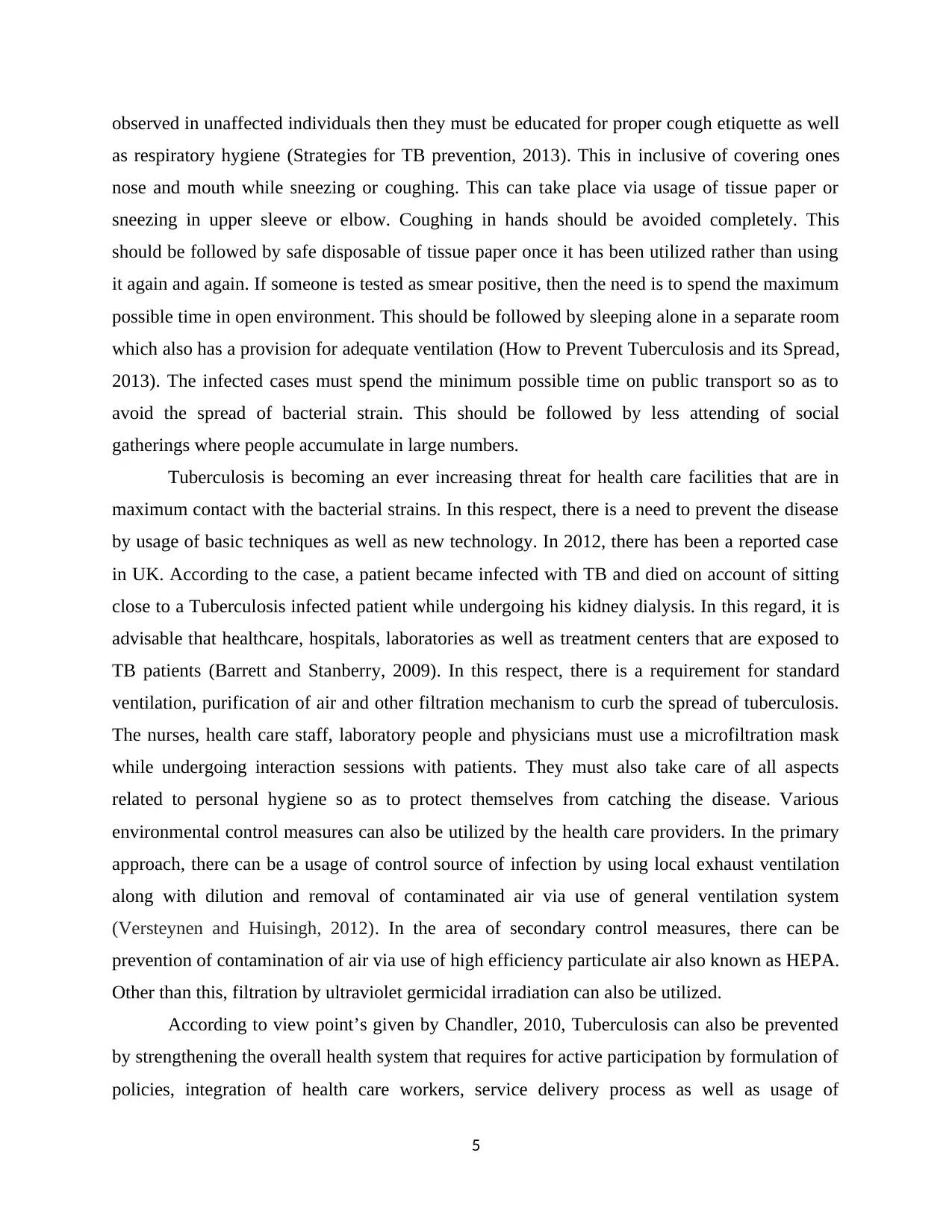
observed in unaffected individuals then they must be educated for proper cough etiquette as well
as respiratory hygiene (Strategies for TB prevention, 2013). This in inclusive of covering ones
nose and mouth while sneezing or coughing. This can take place via usage of tissue paper or
sneezing in upper sleeve or elbow. Coughing in hands should be avoided completely. This
should be followed by safe disposable of tissue paper once it has been utilized rather than using
it again and again. If someone is tested as smear positive, then the need is to spend the maximum
possible time in open environment. This should be followed by sleeping alone in a separate room
which also has a provision for adequate ventilation (How to Prevent Tuberculosis and its Spread,
2013). The infected cases must spend the minimum possible time on public transport so as to
avoid the spread of bacterial strain. This should be followed by less attending of social
gatherings where people accumulate in large numbers.
Tuberculosis is becoming an ever increasing threat for health care facilities that are in
maximum contact with the bacterial strains. In this respect, there is a need to prevent the disease
by usage of basic techniques as well as new technology. In 2012, there has been a reported case
in UK. According to the case, a patient became infected with TB and died on account of sitting
close to a Tuberculosis infected patient while undergoing his kidney dialysis. In this regard, it is
advisable that healthcare, hospitals, laboratories as well as treatment centers that are exposed to
TB patients (Barrett and Stanberry, 2009). In this respect, there is a requirement for standard
ventilation, purification of air and other filtration mechanism to curb the spread of tuberculosis.
The nurses, health care staff, laboratory people and physicians must use a microfiltration mask
while undergoing interaction sessions with patients. They must also take care of all aspects
related to personal hygiene so as to protect themselves from catching the disease. Various
environmental control measures can also be utilized by the health care providers. In the primary
approach, there can be a usage of control source of infection by using local exhaust ventilation
along with dilution and removal of contaminated air via use of general ventilation system
(Versteynen and Huisingh, 2012). In the area of secondary control measures, there can be
prevention of contamination of air via use of high efficiency particulate air also known as HEPA.
Other than this, filtration by ultraviolet germicidal irradiation can also be utilized.
According to view point’s given by Chandler, 2010, Tuberculosis can also be prevented
by strengthening the overall health system that requires for active participation by formulation of
policies, integration of health care workers, service delivery process as well as usage of
5
as respiratory hygiene (Strategies for TB prevention, 2013). This in inclusive of covering ones
nose and mouth while sneezing or coughing. This can take place via usage of tissue paper or
sneezing in upper sleeve or elbow. Coughing in hands should be avoided completely. This
should be followed by safe disposable of tissue paper once it has been utilized rather than using
it again and again. If someone is tested as smear positive, then the need is to spend the maximum
possible time in open environment. This should be followed by sleeping alone in a separate room
which also has a provision for adequate ventilation (How to Prevent Tuberculosis and its Spread,
2013). The infected cases must spend the minimum possible time on public transport so as to
avoid the spread of bacterial strain. This should be followed by less attending of social
gatherings where people accumulate in large numbers.
Tuberculosis is becoming an ever increasing threat for health care facilities that are in
maximum contact with the bacterial strains. In this respect, there is a need to prevent the disease
by usage of basic techniques as well as new technology. In 2012, there has been a reported case
in UK. According to the case, a patient became infected with TB and died on account of sitting
close to a Tuberculosis infected patient while undergoing his kidney dialysis. In this regard, it is
advisable that healthcare, hospitals, laboratories as well as treatment centers that are exposed to
TB patients (Barrett and Stanberry, 2009). In this respect, there is a requirement for standard
ventilation, purification of air and other filtration mechanism to curb the spread of tuberculosis.
The nurses, health care staff, laboratory people and physicians must use a microfiltration mask
while undergoing interaction sessions with patients. They must also take care of all aspects
related to personal hygiene so as to protect themselves from catching the disease. Various
environmental control measures can also be utilized by the health care providers. In the primary
approach, there can be a usage of control source of infection by using local exhaust ventilation
along with dilution and removal of contaminated air via use of general ventilation system
(Versteynen and Huisingh, 2012). In the area of secondary control measures, there can be
prevention of contamination of air via use of high efficiency particulate air also known as HEPA.
Other than this, filtration by ultraviolet germicidal irradiation can also be utilized.
According to view point’s given by Chandler, 2010, Tuberculosis can also be prevented
by strengthening the overall health system that requires for active participation by formulation of
policies, integration of health care workers, service delivery process as well as usage of
5
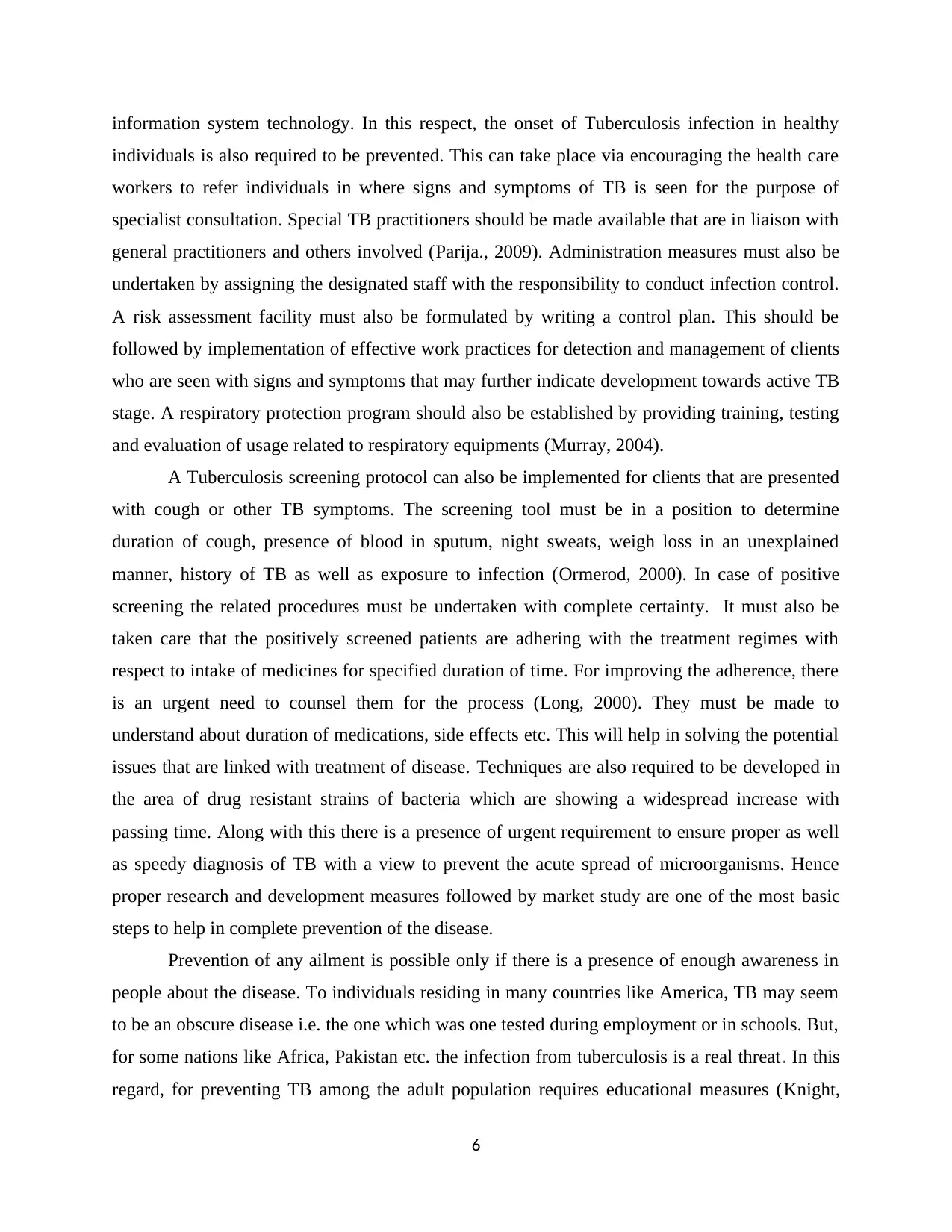
information system technology. In this respect, the onset of Tuberculosis infection in healthy
individuals is also required to be prevented. This can take place via encouraging the health care
workers to refer individuals in where signs and symptoms of TB is seen for the purpose of
specialist consultation. Special TB practitioners should be made available that are in liaison with
general practitioners and others involved (Parija., 2009). Administration measures must also be
undertaken by assigning the designated staff with the responsibility to conduct infection control.
A risk assessment facility must also be formulated by writing a control plan. This should be
followed by implementation of effective work practices for detection and management of clients
who are seen with signs and symptoms that may further indicate development towards active TB
stage. A respiratory protection program should also be established by providing training, testing
and evaluation of usage related to respiratory equipments (Murray, 2004).
A Tuberculosis screening protocol can also be implemented for clients that are presented
with cough or other TB symptoms. The screening tool must be in a position to determine
duration of cough, presence of blood in sputum, night sweats, weigh loss in an unexplained
manner, history of TB as well as exposure to infection (Ormerod, 2000). In case of positive
screening the related procedures must be undertaken with complete certainty. It must also be
taken care that the positively screened patients are adhering with the treatment regimes with
respect to intake of medicines for specified duration of time. For improving the adherence, there
is an urgent need to counsel them for the process (Long, 2000). They must be made to
understand about duration of medications, side effects etc. This will help in solving the potential
issues that are linked with treatment of disease. Techniques are also required to be developed in
the area of drug resistant strains of bacteria which are showing a widespread increase with
passing time. Along with this there is a presence of urgent requirement to ensure proper as well
as speedy diagnosis of TB with a view to prevent the acute spread of microorganisms. Hence
proper research and development measures followed by market study are one of the most basic
steps to help in complete prevention of the disease.
Prevention of any ailment is possible only if there is a presence of enough awareness in
people about the disease. To individuals residing in many countries like America, TB may seem
to be an obscure disease i.e. the one which was one tested during employment or in schools. But,
for some nations like Africa, Pakistan etc. the infection from tuberculosis is a real threat. In this
regard, for preventing TB among the adult population requires educational measures (Knight,
6
individuals is also required to be prevented. This can take place via encouraging the health care
workers to refer individuals in where signs and symptoms of TB is seen for the purpose of
specialist consultation. Special TB practitioners should be made available that are in liaison with
general practitioners and others involved (Parija., 2009). Administration measures must also be
undertaken by assigning the designated staff with the responsibility to conduct infection control.
A risk assessment facility must also be formulated by writing a control plan. This should be
followed by implementation of effective work practices for detection and management of clients
who are seen with signs and symptoms that may further indicate development towards active TB
stage. A respiratory protection program should also be established by providing training, testing
and evaluation of usage related to respiratory equipments (Murray, 2004).
A Tuberculosis screening protocol can also be implemented for clients that are presented
with cough or other TB symptoms. The screening tool must be in a position to determine
duration of cough, presence of blood in sputum, night sweats, weigh loss in an unexplained
manner, history of TB as well as exposure to infection (Ormerod, 2000). In case of positive
screening the related procedures must be undertaken with complete certainty. It must also be
taken care that the positively screened patients are adhering with the treatment regimes with
respect to intake of medicines for specified duration of time. For improving the adherence, there
is an urgent need to counsel them for the process (Long, 2000). They must be made to
understand about duration of medications, side effects etc. This will help in solving the potential
issues that are linked with treatment of disease. Techniques are also required to be developed in
the area of drug resistant strains of bacteria which are showing a widespread increase with
passing time. Along with this there is a presence of urgent requirement to ensure proper as well
as speedy diagnosis of TB with a view to prevent the acute spread of microorganisms. Hence
proper research and development measures followed by market study are one of the most basic
steps to help in complete prevention of the disease.
Prevention of any ailment is possible only if there is a presence of enough awareness in
people about the disease. To individuals residing in many countries like America, TB may seem
to be an obscure disease i.e. the one which was one tested during employment or in schools. But,
for some nations like Africa, Pakistan etc. the infection from tuberculosis is a real threat. In this
regard, for preventing TB among the adult population requires educational measures (Knight,
6
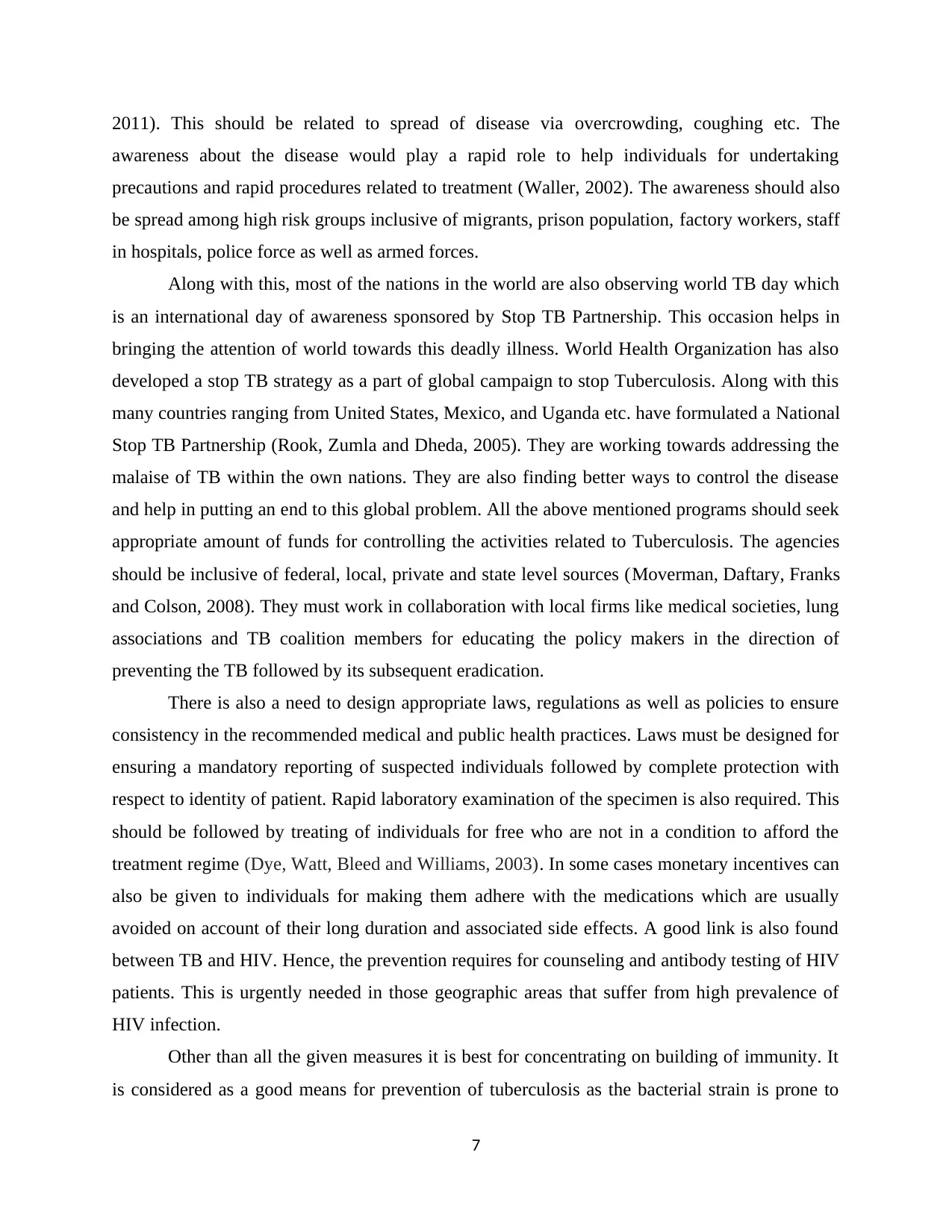
2011). This should be related to spread of disease via overcrowding, coughing etc. The
awareness about the disease would play a rapid role to help individuals for undertaking
precautions and rapid procedures related to treatment (Waller, 2002). The awareness should also
be spread among high risk groups inclusive of migrants, prison population, factory workers, staff
in hospitals, police force as well as armed forces.
Along with this, most of the nations in the world are also observing world TB day which
is an international day of awareness sponsored by Stop TB Partnership. This occasion helps in
bringing the attention of world towards this deadly illness. World Health Organization has also
developed a stop TB strategy as a part of global campaign to stop Tuberculosis. Along with this
many countries ranging from United States, Mexico, and Uganda etc. have formulated a National
Stop TB Partnership (Rook, Zumla and Dheda, 2005). They are working towards addressing the
malaise of TB within the own nations. They are also finding better ways to control the disease
and help in putting an end to this global problem. All the above mentioned programs should seek
appropriate amount of funds for controlling the activities related to Tuberculosis. The agencies
should be inclusive of federal, local, private and state level sources (Moverman, Daftary, Franks
and Colson, 2008). They must work in collaboration with local firms like medical societies, lung
associations and TB coalition members for educating the policy makers in the direction of
preventing the TB followed by its subsequent eradication.
There is also a need to design appropriate laws, regulations as well as policies to ensure
consistency in the recommended medical and public health practices. Laws must be designed for
ensuring a mandatory reporting of suspected individuals followed by complete protection with
respect to identity of patient. Rapid laboratory examination of the specimen is also required. This
should be followed by treating of individuals for free who are not in a condition to afford the
treatment regime (Dye, Watt, Bleed and Williams, 2003). In some cases monetary incentives can
also be given to individuals for making them adhere with the medications which are usually
avoided on account of their long duration and associated side effects. A good link is also found
between TB and HIV. Hence, the prevention requires for counseling and antibody testing of HIV
patients. This is urgently needed in those geographic areas that suffer from high prevalence of
HIV infection.
Other than all the given measures it is best for concentrating on building of immunity. It
is considered as a good means for prevention of tuberculosis as the bacterial strain is prone to
7
awareness about the disease would play a rapid role to help individuals for undertaking
precautions and rapid procedures related to treatment (Waller, 2002). The awareness should also
be spread among high risk groups inclusive of migrants, prison population, factory workers, staff
in hospitals, police force as well as armed forces.
Along with this, most of the nations in the world are also observing world TB day which
is an international day of awareness sponsored by Stop TB Partnership. This occasion helps in
bringing the attention of world towards this deadly illness. World Health Organization has also
developed a stop TB strategy as a part of global campaign to stop Tuberculosis. Along with this
many countries ranging from United States, Mexico, and Uganda etc. have formulated a National
Stop TB Partnership (Rook, Zumla and Dheda, 2005). They are working towards addressing the
malaise of TB within the own nations. They are also finding better ways to control the disease
and help in putting an end to this global problem. All the above mentioned programs should seek
appropriate amount of funds for controlling the activities related to Tuberculosis. The agencies
should be inclusive of federal, local, private and state level sources (Moverman, Daftary, Franks
and Colson, 2008). They must work in collaboration with local firms like medical societies, lung
associations and TB coalition members for educating the policy makers in the direction of
preventing the TB followed by its subsequent eradication.
There is also a need to design appropriate laws, regulations as well as policies to ensure
consistency in the recommended medical and public health practices. Laws must be designed for
ensuring a mandatory reporting of suspected individuals followed by complete protection with
respect to identity of patient. Rapid laboratory examination of the specimen is also required. This
should be followed by treating of individuals for free who are not in a condition to afford the
treatment regime (Dye, Watt, Bleed and Williams, 2003). In some cases monetary incentives can
also be given to individuals for making them adhere with the medications which are usually
avoided on account of their long duration and associated side effects. A good link is also found
between TB and HIV. Hence, the prevention requires for counseling and antibody testing of HIV
patients. This is urgently needed in those geographic areas that suffer from high prevalence of
HIV infection.
Other than all the given measures it is best for concentrating on building of immunity. It
is considered as a good means for prevention of tuberculosis as the bacterial strain is prone to
7
Paraphrase This Document
Need a fresh take? Get an instant paraphrase of this document with our AI Paraphraser
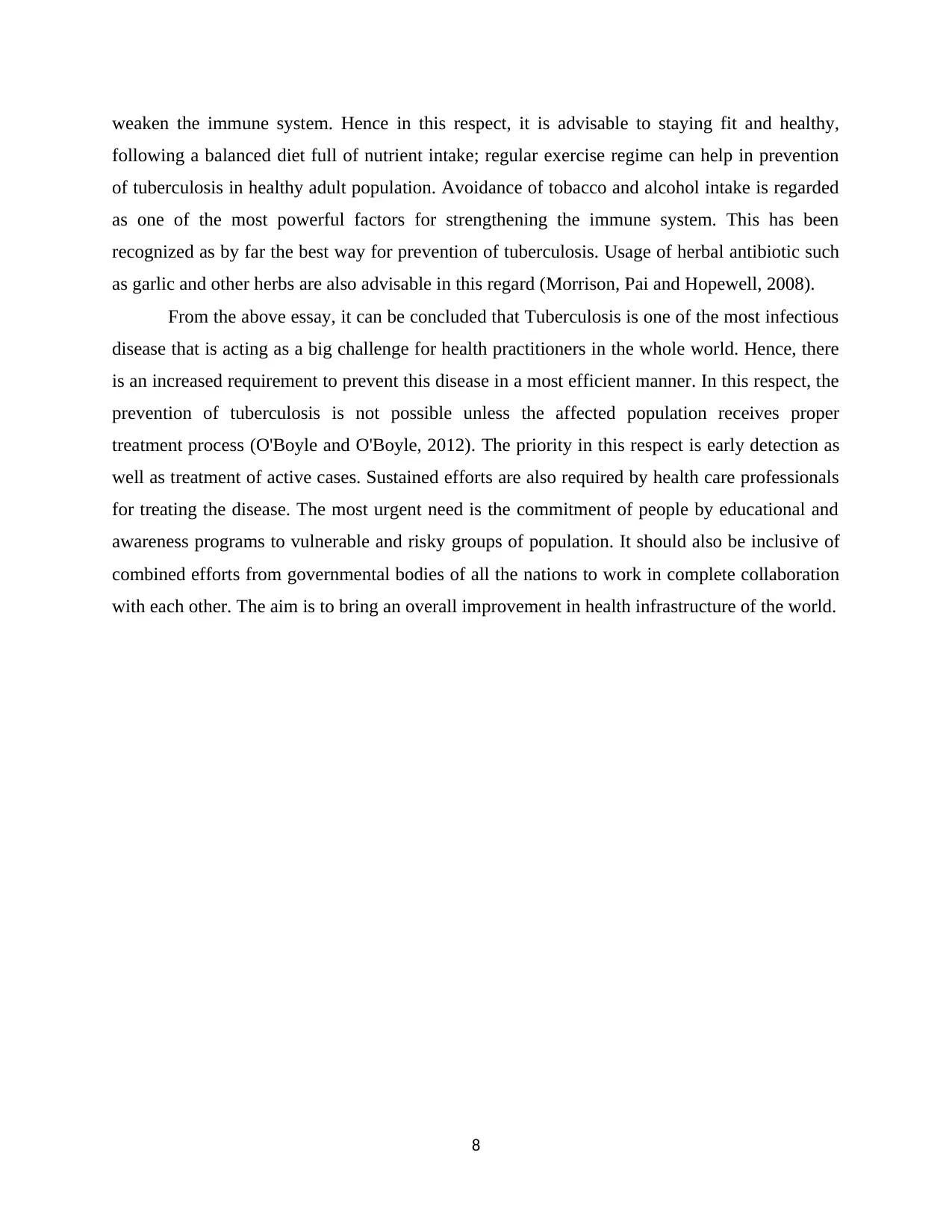
weaken the immune system. Hence in this respect, it is advisable to staying fit and healthy,
following a balanced diet full of nutrient intake; regular exercise regime can help in prevention
of tuberculosis in healthy adult population. Avoidance of tobacco and alcohol intake is regarded
as one of the most powerful factors for strengthening the immune system. This has been
recognized as by far the best way for prevention of tuberculosis. Usage of herbal antibiotic such
as garlic and other herbs are also advisable in this regard (Morrison, Pai and Hopewell, 2008).
From the above essay, it can be concluded that Tuberculosis is one of the most infectious
disease that is acting as a big challenge for health practitioners in the whole world. Hence, there
is an increased requirement to prevent this disease in a most efficient manner. In this respect, the
prevention of tuberculosis is not possible unless the affected population receives proper
treatment process (O'Boyle and O'Boyle, 2012). The priority in this respect is early detection as
well as treatment of active cases. Sustained efforts are also required by health care professionals
for treating the disease. The most urgent need is the commitment of people by educational and
awareness programs to vulnerable and risky groups of population. It should also be inclusive of
combined efforts from governmental bodies of all the nations to work in complete collaboration
with each other. The aim is to bring an overall improvement in health infrastructure of the world.
8
following a balanced diet full of nutrient intake; regular exercise regime can help in prevention
of tuberculosis in healthy adult population. Avoidance of tobacco and alcohol intake is regarded
as one of the most powerful factors for strengthening the immune system. This has been
recognized as by far the best way for prevention of tuberculosis. Usage of herbal antibiotic such
as garlic and other herbs are also advisable in this regard (Morrison, Pai and Hopewell, 2008).
From the above essay, it can be concluded that Tuberculosis is one of the most infectious
disease that is acting as a big challenge for health practitioners in the whole world. Hence, there
is an increased requirement to prevent this disease in a most efficient manner. In this respect, the
prevention of tuberculosis is not possible unless the affected population receives proper
treatment process (O'Boyle and O'Boyle, 2012). The priority in this respect is early detection as
well as treatment of active cases. Sustained efforts are also required by health care professionals
for treating the disease. The most urgent need is the commitment of people by educational and
awareness programs to vulnerable and risky groups of population. It should also be inclusive of
combined efforts from governmental bodies of all the nations to work in complete collaboration
with each other. The aim is to bring an overall improvement in health infrastructure of the world.
8
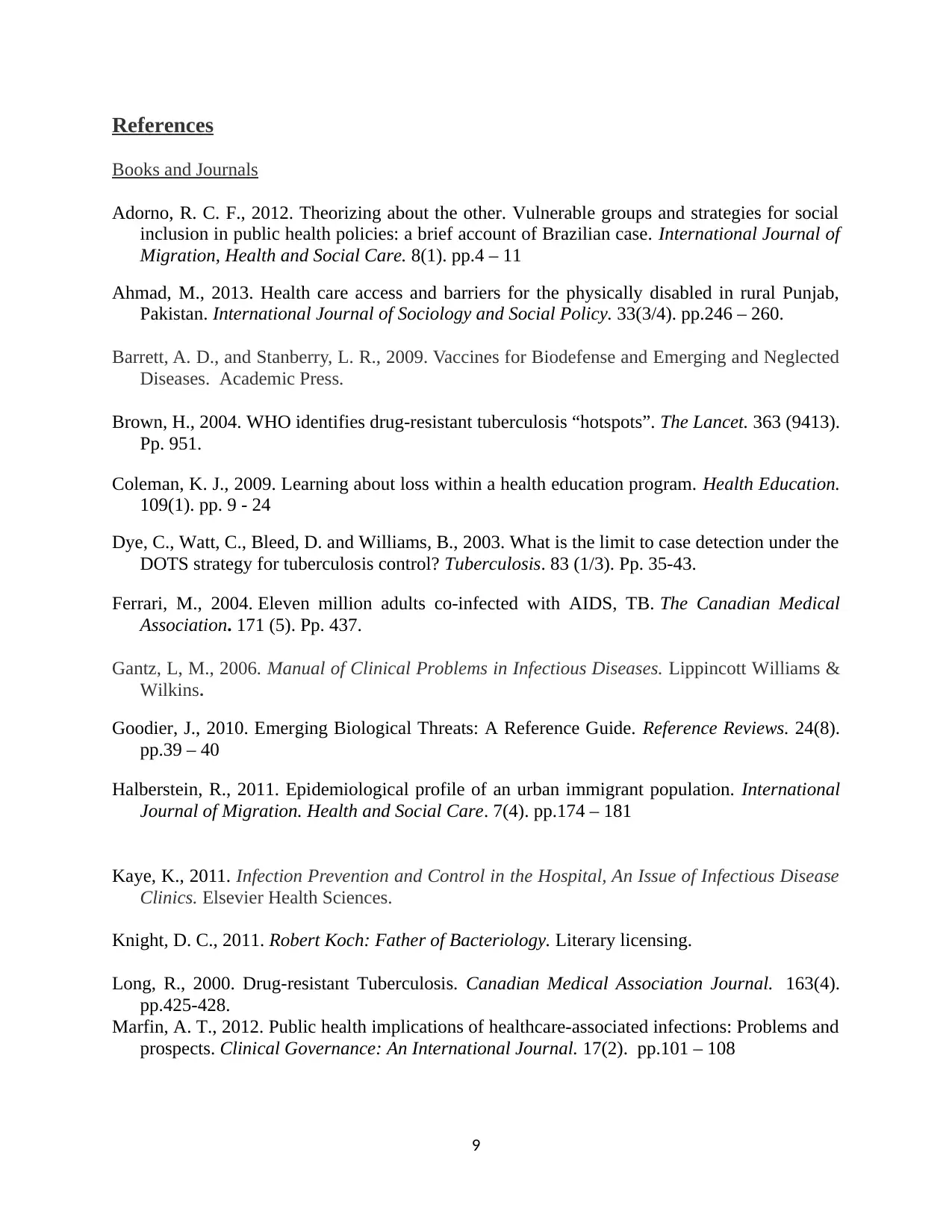
References
Books and Journals
Adorno, R. C. F., 2012. Theorizing about the other. Vulnerable groups and strategies for social
inclusion in public health policies: a brief account of Brazilian case. International Journal of
Migration, Health and Social Care. 8(1). pp.4 – 11
Ahmad, M., 2013. Health care access and barriers for the physically disabled in rural Punjab,
Pakistan. International Journal of Sociology and Social Policy. 33(3/4). pp.246 – 260.
Barrett, A. D., and Stanberry, L. R., 2009. Vaccines for Biodefense and Emerging and Neglected
Diseases. Academic Press.
Brown, H., 2004. WHO identifies drug-resistant tuberculosis “hotspots”. The Lancet. 363 (9413).
Pp. 951.
Coleman, K. J., 2009. Learning about loss within a health education program. Health Education.
109(1). pp. 9 - 24
Dye, C., Watt, C., Bleed, D. and Williams, B., 2003. What is the limit to case detection under the
DOTS strategy for tuberculosis control? Tuberculosis. 83 (1/3). Pp. 35-43.
Ferrari, M., 2004. Eleven million adults co-infected with AIDS, TB. The Canadian Medical
Association. 171 (5). Pp. 437.
Gantz, L, M., 2006. Manual of Clinical Problems in Infectious Diseases. Lippincott Williams &
Wilkins.
Goodier, J., 2010. Emerging Biological Threats: A Reference Guide. Reference Reviews. 24(8).
pp.39 – 40
Halberstein, R., 2011. Epidemiological profile of an urban immigrant population. International
Journal of Migration. Health and Social Care. 7(4). pp.174 – 181
Kaye, K., 2011. Infection Prevention and Control in the Hospital, An Issue of Infectious Disease
Clinics. Elsevier Health Sciences.
Knight, D. C., 2011. Robert Koch: Father of Bacteriology. Literary licensing.
Long, R., 2000. Drug-resistant Tuberculosis. Canadian Medical Association Journal. 163(4).
pp.425-428.
Marfin, A. T., 2012. Public health implications of healthcare-associated infections: Problems and
prospects. Clinical Governance: An International Journal. 17(2). pp.101 – 108
9
Books and Journals
Adorno, R. C. F., 2012. Theorizing about the other. Vulnerable groups and strategies for social
inclusion in public health policies: a brief account of Brazilian case. International Journal of
Migration, Health and Social Care. 8(1). pp.4 – 11
Ahmad, M., 2013. Health care access and barriers for the physically disabled in rural Punjab,
Pakistan. International Journal of Sociology and Social Policy. 33(3/4). pp.246 – 260.
Barrett, A. D., and Stanberry, L. R., 2009. Vaccines for Biodefense and Emerging and Neglected
Diseases. Academic Press.
Brown, H., 2004. WHO identifies drug-resistant tuberculosis “hotspots”. The Lancet. 363 (9413).
Pp. 951.
Coleman, K. J., 2009. Learning about loss within a health education program. Health Education.
109(1). pp. 9 - 24
Dye, C., Watt, C., Bleed, D. and Williams, B., 2003. What is the limit to case detection under the
DOTS strategy for tuberculosis control? Tuberculosis. 83 (1/3). Pp. 35-43.
Ferrari, M., 2004. Eleven million adults co-infected with AIDS, TB. The Canadian Medical
Association. 171 (5). Pp. 437.
Gantz, L, M., 2006. Manual of Clinical Problems in Infectious Diseases. Lippincott Williams &
Wilkins.
Goodier, J., 2010. Emerging Biological Threats: A Reference Guide. Reference Reviews. 24(8).
pp.39 – 40
Halberstein, R., 2011. Epidemiological profile of an urban immigrant population. International
Journal of Migration. Health and Social Care. 7(4). pp.174 – 181
Kaye, K., 2011. Infection Prevention and Control in the Hospital, An Issue of Infectious Disease
Clinics. Elsevier Health Sciences.
Knight, D. C., 2011. Robert Koch: Father of Bacteriology. Literary licensing.
Long, R., 2000. Drug-resistant Tuberculosis. Canadian Medical Association Journal. 163(4).
pp.425-428.
Marfin, A. T., 2012. Public health implications of healthcare-associated infections: Problems and
prospects. Clinical Governance: An International Journal. 17(2). pp.101 – 108
9
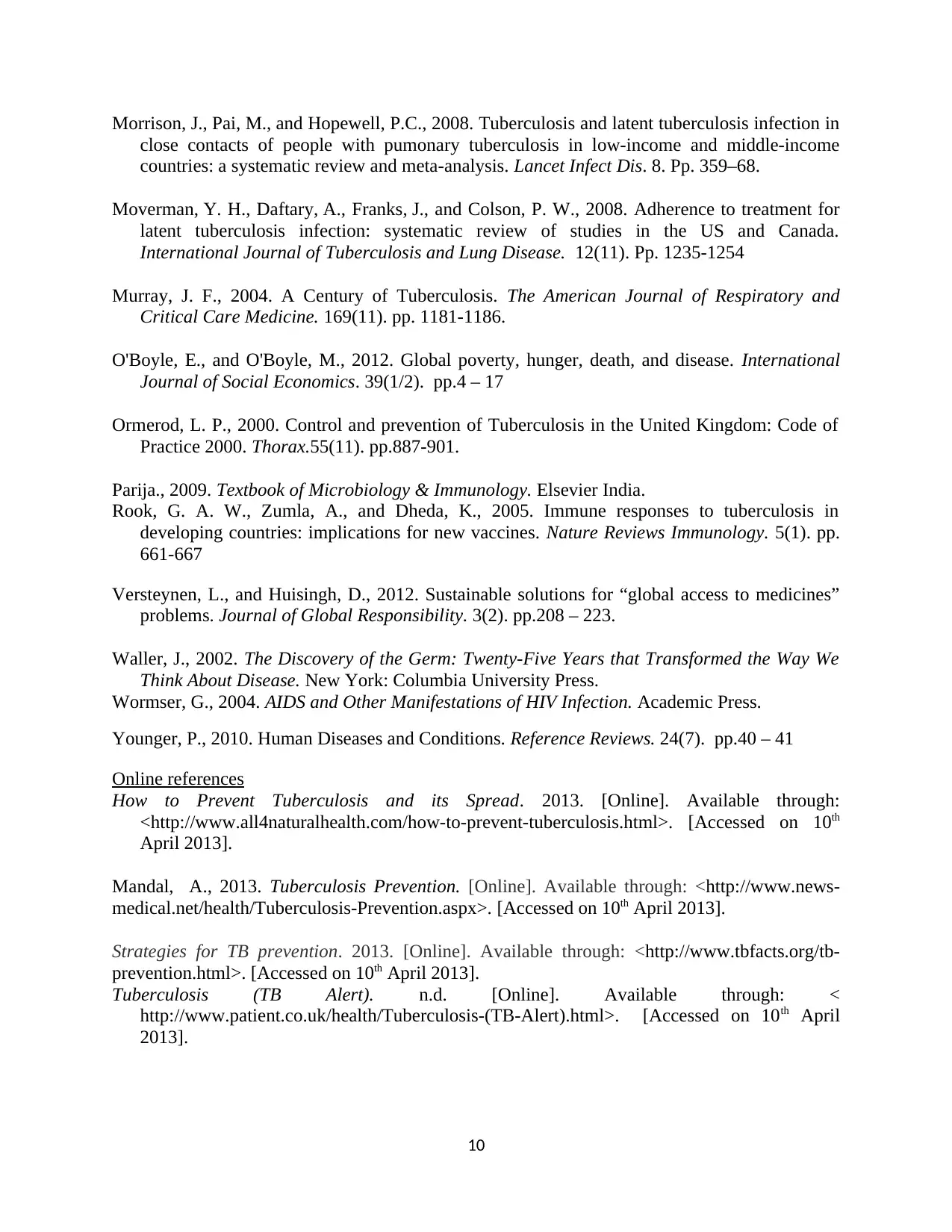
Morrison, J., Pai, M., and Hopewell, P.C., 2008. Tuberculosis and latent tuberculosis infection in
close contacts of people with pumonary tuberculosis in low-income and middle-income
countries: a systematic review and meta-analysis. Lancet Infect Dis. 8. Pp. 359–68.
Moverman, Y. H., Daftary, A., Franks, J., and Colson, P. W., 2008. Adherence to treatment for
latent tuberculosis infection: systematic review of studies in the US and Canada.
International Journal of Tuberculosis and Lung Disease. 12(11). Pp. 1235-1254
Murray, J. F., 2004. A Century of Tuberculosis. The American Journal of Respiratory and
Critical Care Medicine. 169(11). pp. 1181-1186.
O'Boyle, E., and O'Boyle, M., 2012. Global poverty, hunger, death, and disease. International
Journal of Social Economics. 39(1/2). pp.4 – 17
Ormerod, L. P., 2000. Control and prevention of Tuberculosis in the United Kingdom: Code of
Practice 2000. Thorax.55(11). pp.887-901.
Parija., 2009. Textbook of Microbiology & Immunology. Elsevier India.
Rook, G. A. W., Zumla, A., and Dheda, K., 2005. Immune responses to tuberculosis in
developing countries: implications for new vaccines. Nature Reviews Immunology. 5(1). pp.
661-667
Versteynen, L., and Huisingh, D., 2012. Sustainable solutions for “global access to medicines”
problems. Journal of Global Responsibility. 3(2). pp.208 – 223.
Waller, J., 2002. The Discovery of the Germ: Twenty-Five Years that Transformed the Way We
Think About Disease. New York: Columbia University Press.
Wormser, G., 2004. AIDS and Other Manifestations of HIV Infection. Academic Press.
Younger, P., 2010. Human Diseases and Conditions. Reference Reviews. 24(7). pp.40 – 41
Online references
How to Prevent Tuberculosis and its Spread. 2013. [Online]. Available through:
<http://www.all4naturalhealth.com/how-to-prevent-tuberculosis.html>. [Accessed on 10th
April 2013].
Mandal, A., 2013. Tuberculosis Prevention. [Online]. Available through: <http://www.news-
medical.net/health/Tuberculosis-Prevention.aspx>. [Accessed on 10th April 2013].
Strategies for TB prevention. 2013. [Online]. Available through: <http://www.tbfacts.org/tb-
prevention.html>. [Accessed on 10th April 2013].
Tuberculosis (TB Alert). n.d. [Online]. Available through: <
http://www.patient.co.uk/health/Tuberculosis-(TB-Alert).html>. [Accessed on 10th April
2013].
10
close contacts of people with pumonary tuberculosis in low-income and middle-income
countries: a systematic review and meta-analysis. Lancet Infect Dis. 8. Pp. 359–68.
Moverman, Y. H., Daftary, A., Franks, J., and Colson, P. W., 2008. Adherence to treatment for
latent tuberculosis infection: systematic review of studies in the US and Canada.
International Journal of Tuberculosis and Lung Disease. 12(11). Pp. 1235-1254
Murray, J. F., 2004. A Century of Tuberculosis. The American Journal of Respiratory and
Critical Care Medicine. 169(11). pp. 1181-1186.
O'Boyle, E., and O'Boyle, M., 2012. Global poverty, hunger, death, and disease. International
Journal of Social Economics. 39(1/2). pp.4 – 17
Ormerod, L. P., 2000. Control and prevention of Tuberculosis in the United Kingdom: Code of
Practice 2000. Thorax.55(11). pp.887-901.
Parija., 2009. Textbook of Microbiology & Immunology. Elsevier India.
Rook, G. A. W., Zumla, A., and Dheda, K., 2005. Immune responses to tuberculosis in
developing countries: implications for new vaccines. Nature Reviews Immunology. 5(1). pp.
661-667
Versteynen, L., and Huisingh, D., 2012. Sustainable solutions for “global access to medicines”
problems. Journal of Global Responsibility. 3(2). pp.208 – 223.
Waller, J., 2002. The Discovery of the Germ: Twenty-Five Years that Transformed the Way We
Think About Disease. New York: Columbia University Press.
Wormser, G., 2004. AIDS and Other Manifestations of HIV Infection. Academic Press.
Younger, P., 2010. Human Diseases and Conditions. Reference Reviews. 24(7). pp.40 – 41
Online references
How to Prevent Tuberculosis and its Spread. 2013. [Online]. Available through:
<http://www.all4naturalhealth.com/how-to-prevent-tuberculosis.html>. [Accessed on 10th
April 2013].
Mandal, A., 2013. Tuberculosis Prevention. [Online]. Available through: <http://www.news-
medical.net/health/Tuberculosis-Prevention.aspx>. [Accessed on 10th April 2013].
Strategies for TB prevention. 2013. [Online]. Available through: <http://www.tbfacts.org/tb-
prevention.html>. [Accessed on 10th April 2013].
Tuberculosis (TB Alert). n.d. [Online]. Available through: <
http://www.patient.co.uk/health/Tuberculosis-(TB-Alert).html>. [Accessed on 10th April
2013].
10
Secure Best Marks with AI Grader
Need help grading? Try our AI Grader for instant feedback on your assignments.
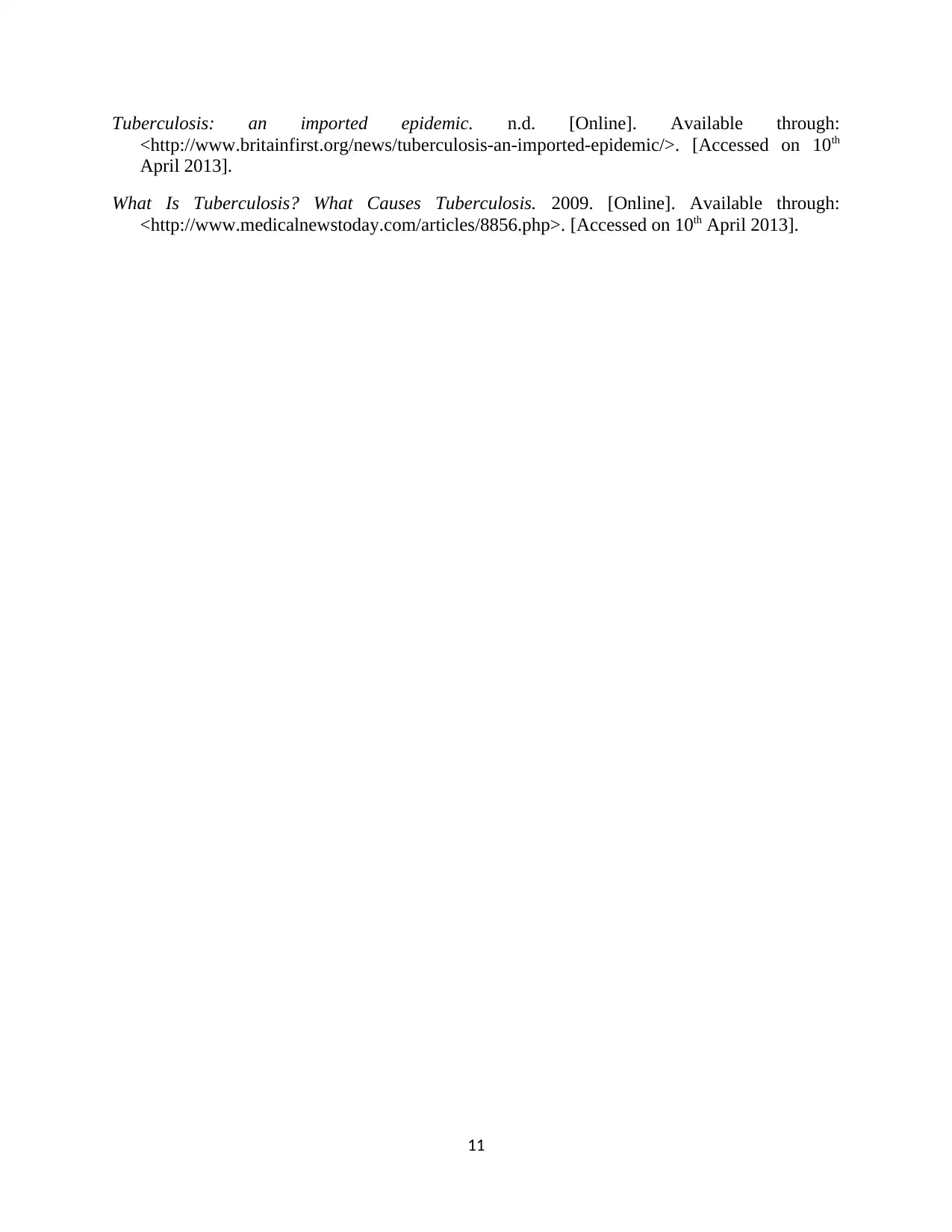
Tuberculosis: an imported epidemic. n.d. [Online]. Available through:
<http://www.britainfirst.org/news/tuberculosis-an-imported-epidemic/>. [Accessed on 10th
April 2013].
What Is Tuberculosis? What Causes Tuberculosis. 2009. [Online]. Available through:
<http://www.medicalnewstoday.com/articles/8856.php>. [Accessed on 10th April 2013].
11
<http://www.britainfirst.org/news/tuberculosis-an-imported-epidemic/>. [Accessed on 10th
April 2013].
What Is Tuberculosis? What Causes Tuberculosis. 2009. [Online]. Available through:
<http://www.medicalnewstoday.com/articles/8856.php>. [Accessed on 10th April 2013].
11
1 out of 11
Related Documents
Your All-in-One AI-Powered Toolkit for Academic Success.
+13062052269
info@desklib.com
Available 24*7 on WhatsApp / Email
![[object Object]](/_next/static/media/star-bottom.7253800d.svg)
Unlock your academic potential
© 2024 | Zucol Services PVT LTD | All rights reserved.





